My children skipped summer break. Yes, you read that right. They were SO excited to start Ancient History from Beautiful Feet Books and continue on with Right Start Math and IEW and all the rest that they canceled their own summer break. We’re giving year round schooling a try. Six week on, one week off. Something tells me we will be sticking with it for a long time. In these posts I will be sharing about our studies with an in depth look at how we blend Charlotte Mason and Classical Education. This first post is heavy on the set up and light on the practical blending, but as time moves on I’ll have more room for greater specificity. Here is a look at our first two weeks on the new schedule.
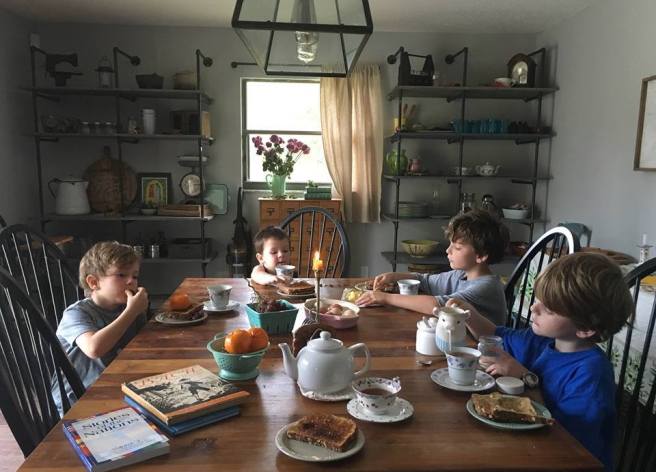
Morning Time:
Genesis 1-20
A Midsummer Night’s Dream by William Shakespeare
Hymn: “O God Our Help in Ages Past.”
Giotto Tended the Sheep by Opal Wheeler
Simply Charlotte Mason Picture Study Portfolio: Giotto
Speaking Spanish with Miss Mason and Francois
Poem: “The Moon” by Robert Louis Stevenson, “Opportunity” By Edward Sill
Biography: “Mathematicians are People, Too. Vol. 2” by Luella Reimer
Geography: Visits to Africa
Handwriting: Classical Conversations Prescripts
Composer: Corelli and Vivaldi
Ancient History with Beautiful Feet Books
Let’s begin by saying that this guide is geared for 4th grade-7th grade in the Intermediate section, which is the first half of the book, and 8th-12th grade in the Advanced Section, which is found in the second half of the book. My two boys are now in 4th grade so I am making adjustments as needed since they are at the very bottom of the recommended age range. The first four lessons of the guide cover Creation- Hammurabi.
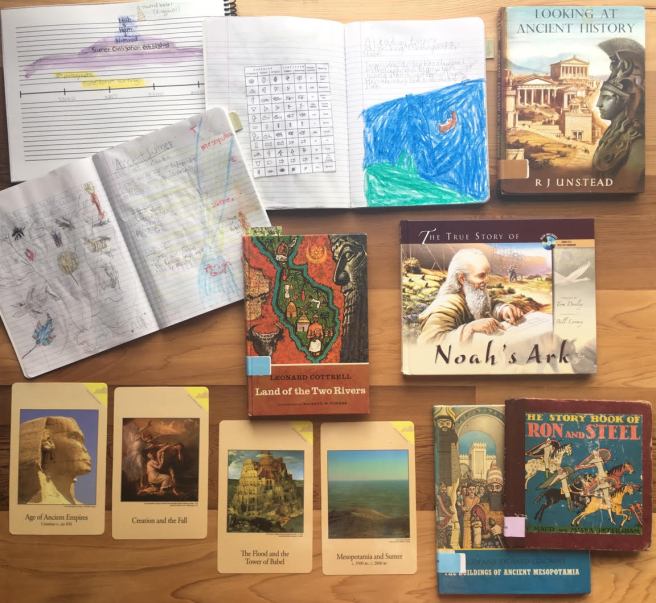
I love how open-ended Beautiful Feet Books is. Enough direction to keep us on track but the overall unscripted assignments allow us to really follow our interests for each section which is so life-giving and keeps the boys engaged, invested and eager to dig for more!
One of the main texts used in the first four lessons is a TEXTBOOK called Streams of Civilizations. It is obviously not a living book and to be honest, if I read every word aloud my kids would have probably run away screaming. I took time before we started this unit and read through the first assigned chapters of Streams of Civilizations so that I could have a grasp of where things were headed. I marked interesting sections to read aloud to the boys and then I went in search of living books that explained the unmarked sections in a more engaging way. I’ll add our book list at the end of the post.
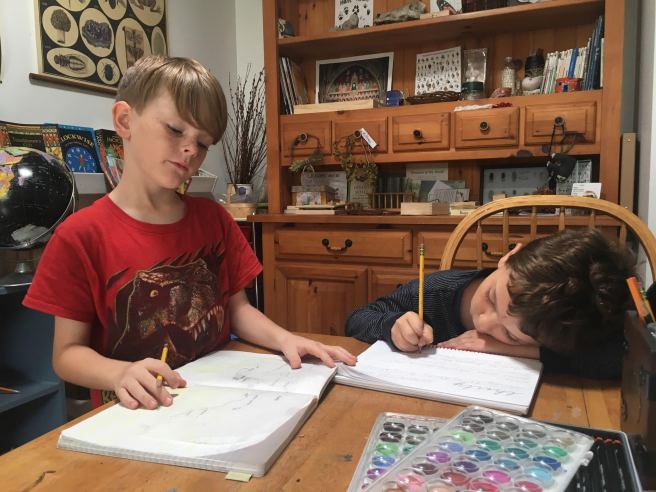
A couple of set up notes for everyone following along. The boys will be filling out a standard composition notebook for their Ancient History study. Maps, narrations, drawings, terms, research etc. are contained within. The boys have dubbed them “Field Journals.” We also have picture story pads from Miller Pads & Paper for all of their Bible reading narrations. Secretly, I am using these notebooks to ease them over to more formal written narrations. We divide the scripture reading over a period of a few days and each time we read the boys narrate the story, then we get out our Bible Journals (picture story pads) and they illustrate what they learned. On a separate sheet of notebook paper they write out a few sentences/short paragraph about the story in their own words. I check for any spelling mistakes and then the sentences are written out once more in their best handwriting in the notebook. (All spelling mistakes are added to a list and then worked on at the end of the day). The written narrations will lengthen over time. We are also using a Book of Centuries from Miller Pads & Paper and updating it every day.
Lesson 1
We stretched the first lesson out over a period of three days. We spent the first day reading through the entire Genesis account of creation, narrating and discussing it. Day two was spent reading about evolution and going through Streams of Civilizations. The third day was spent further discussing terms found in the Streams of Civilization book. Everything from uniformitarianism to sequence dating. I am a bit surprised that the kids were so excited about their glossaries! We read additional living books each day and on the third day we also read several living books about archeology and anthropology and even went on a “dig” in the backyard to uncover some chicken bones I had buried the day before. Have you checked out the newly released film “Is Genesis History?” The boys and I saw it in the theater a few weeks before our study began and it was such a helpful starting point for our discussions about Creation, Evolution and the Flood. We spent the remainder of our time on the third day researching the bronze age before the lesson migrated to the backyard with the boys all fashioning spears and weapons out of rocks. I probably should have seen that coming.
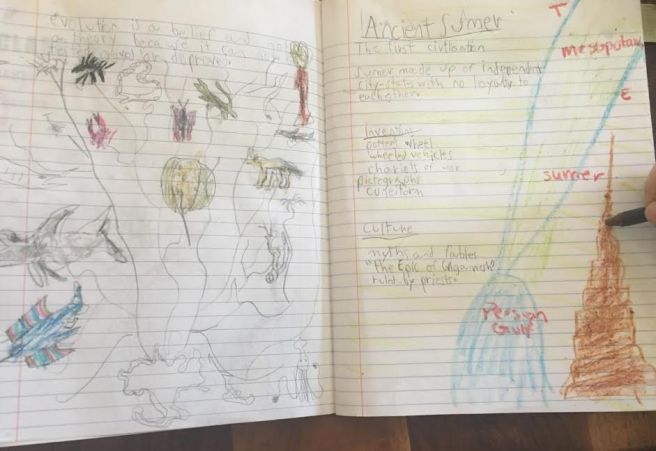
Lesson 2
I really love that the moment we opened our book about Noah, a rainstorm began outside. It felt like a hug from the Lord. When the boys were younger we looked at Peter Spier’s book Noah’s Ark and the flood account in the Bible beginning in Genesis 6. This time we also added in the phenomenal Tom Dooley book, The True Story of Noah’s Ark
The boys responded so well to it that I am now considering a trip to the Creation Museum in Kentucky this fall so they can see the Ark replica. We spent a full day on the Flood topic and made sure to read flood accounts from around the world. We also discussed geological studies about the flood which were quite fascinating. On our second day with lesson two we read an excellent account about Sumer, Akkad and Sargon in the book “Ancient Egypt and Her Neighbors” by Lorene Lambert. This book is EXCEPTIONAL and a much better read than the Streams of Civilization account. I did highlight a few terms and excerpts to go over with the children from Streams after we finished reading from Lambert’s book. We brought out some Crayola Terra Cotta Air Dry Clay 2.5 lb Bucket
and wrote our names in the cuneiform language using popsicle sticks.
Lesson 3
Ziggurats. These kids were captivated by ziggurats. They built several versions of ziggurats out of legos while I read stories about Mesopotamia, Babylon and the Tower of Babel. When it was time to read about Abram and trace the map of his journey the boys sat up a bit straighter and pointed with wide eyes to the city of Aleppo, which we just discussed at the end of our Exploring Countries and Cultures study. I always try to compare the ancient maps to the modern day maps so the boys can see where everything is now. We pulled out our giant timeline to see how things were weaving together. My eldest mused at the end of the lesson, “Ancient history still really matters today doesn’t it? Its hard to talk about anything political if you don’t understand the history of a place.”
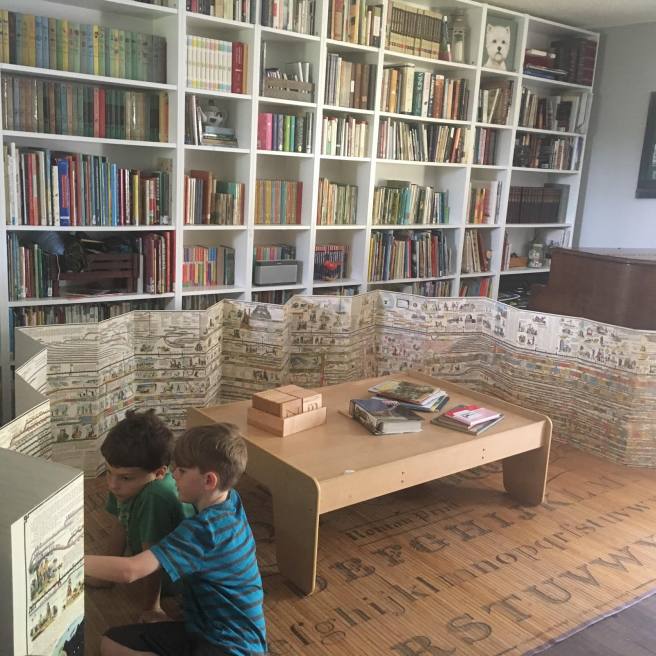
Lesson 4
Again, Lorene Lambert saves the day. Don’t get me wrong, Streams of Civilization is helpful, but nothing beats a living books account of a topic you want your children to experience and bond with. Her account of Babylon, Nebechednezzer and Hammurabi was excellent. We made sure to visit the Louvre for a close look at the Code of Hammurabi stele. The boys made more recordings in their notebooks. We also took our first look at the beginnings of the Egyptian Civilization and the boys were completely captivated.
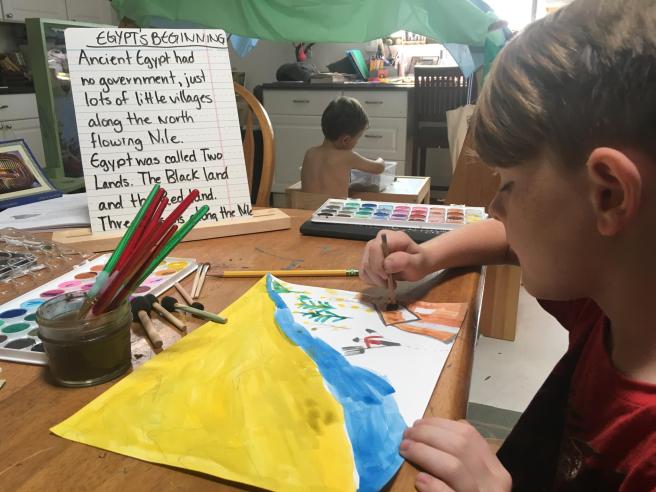
Lesson 4.5
Ok there is no lesson 4.5, but I wanted to read about the Assyrians, Hittites and Persians so I made a lesson 4.5. Plus, the kids were begging to learn more about the Indus River Valley Civilizations from our Classical Conversations Timeline. We mainly used Lorene Lambert’s book but we also included a few living books found in the list below. We also pulled out our Pin it! Maps for some more geography practice and a chance for the boys to narrate a bit about life along these four rivers. We spent another chunk of time talking about irrigation and drawing plans for a system in our orchard.

Science
We did an in depth animal study for science during these lessons. We studied camels! What unbelievable fascinating creatures they are! Our two primary texts happen to be out of print books, but you can visit any public library and find plenty of great books on camels!
Since we happened to study no less than FIVE major rivers these past two weeks: the Nile, Tigris, Euphrates, Indus during Ancient History study and the Yangtze river during my first grader’s FIAR study. we decided to conduct a few experiments with stream flow.
We also went online to see photos and video of the headwaters for each river.
We butchered a pig on our farm last weekend and the boys helped us to package everything. We also saved some of the organs for dissection and microscope inspection.
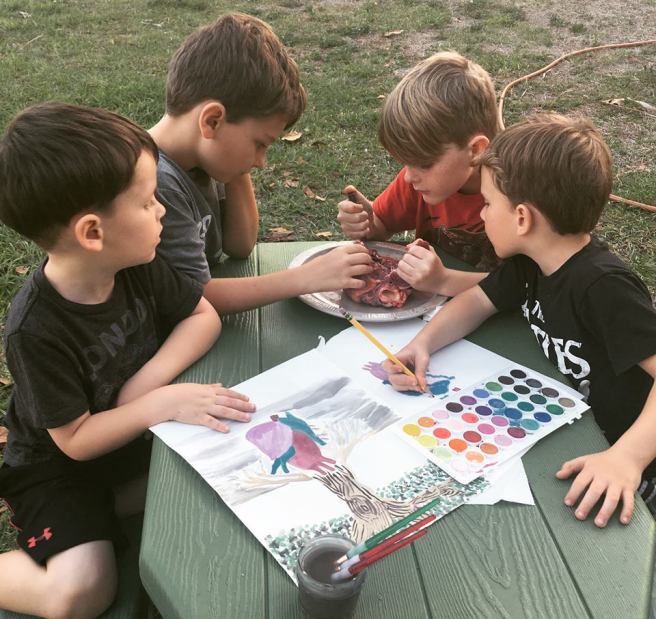
Math
We are now using Right Start Math and LOVING IT. Once we have worked on our daily portion of History, we take a quick break and return for a math lesson and some games. For those unfamiliar with Right Start, the program comes with a spiral bound book of Math Games that helps children gain greater fluency in their math skills. It is not unusual to find my children playing these games together long after math is over. We take breaks between every subject and right now, math is the time of day when the kids forgo the break and keep chipping away at their games and lessons. The transition from Saxon has been much more fluid than I initially anticipated. We started a level lower than they were at with Saxon and I am so glad we did! I can’t believe how many foundational things my children had missed out on. They’re already demonstrating a greater understanding of mathematics. They aren’t just giving answers, they can now explain the WHY behind their answers. I am finding that this program is extremely helpful for my dyslexic learner. He has loved using his abacus and everything is flowing so much faster now.

Latin
We are progressing well with our Memoria Press Latin. After a solid year of Latin its great to hear the boys come across a derivative in their regular reading and hear them chirp out the Latin word it comes from. “Ha! Navigate. That SO comes from navigo.”
IEW
We are still faithfully chipping away at Student Writing Intensive Level A as we prepare for our first upcoming year of Essentials. I am seeing tremendous improvement in my children as they work through this program. My twice exceptional son (dyslexia and creatively gifted) is flourishing right now. He loves the assignments and appreciates their meaty brevity. I’ll be posting more in depth about this program in the weeks to come!
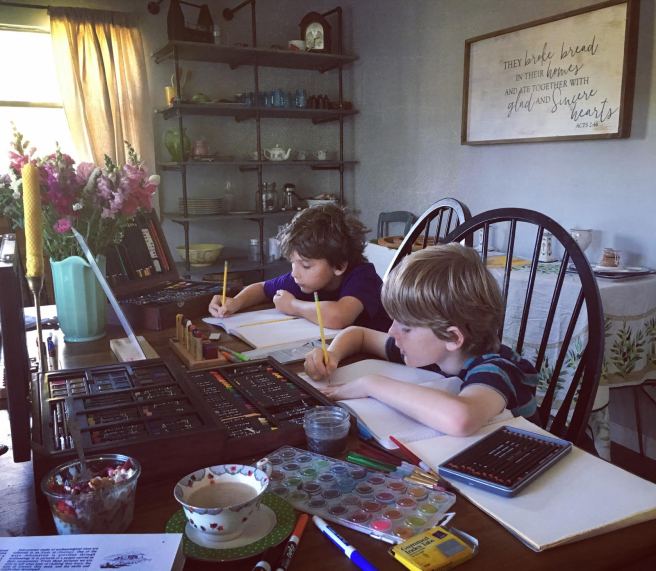
Music
Our History of Classical Music Study from Beautiful Feet Books takes place every Friday morning. After taking up so many new instrument this year I realized that the time was ripe for capitalizing on this family interest. This study does not disappoint. We complete one lesson each week and we could not be happier with our lessons. We seem to have fallen into the habit of preparing a cup of cocoa and gathering round our CD player as we listen to our Music Masters CDs. My eldest usually draws while he listens and my second born works on his knitting or crochet work. We are recording our work in these lovely lesson books.

Friday Exam
Our last two Friday exams were a blend of oral questions from the Streams of Civilizations tests and narrations from the boys about what stuck out most in their minds. They have vivid recall of every battle I mentioned in the past two weeks. They also carried forward quite a bit about Sargon and the flooding of the Nile each year in Egypt. If you don’t know about our Friday exams, you can read about them here.
Symposium
Friday afternoons will never be the same! After lunch I let my youngest children watch Mr Rogers neighborhood on my laptop and the older kids and I cozy up on the couch and we discuss, debate, ask questions and exchange ideas on things we learned throughout the week. This has become our prime time for witnessing the fruits of blending Charlotte Mason and Classical Education. We pull out our timeline cards and retrieve some of our cycle 1 memory work from Classical Conversations. The exchange of bigger ideas begins to happen in this space and I am witnessing their slow transition to the dialectic phase. I often bring some sort of hands on work for us to do while we converse. A few weeks ago we ran stitches through canvas while discussing the sea voyage of Columbus in anticipation of our visit to the Niña and Pinta replicas. This task made a tactile connection in their brain about Columbus that built relationship to the event. Poetic Knowledge: The Recovery of Education. Poetic knowledge is a powerful thing!
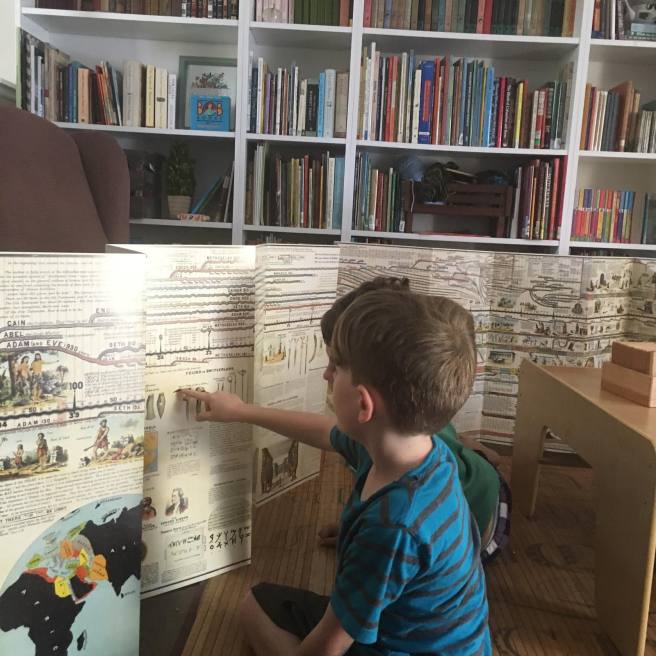
Extra Curricular
The boys practiced their individual instruments after Blessing Hour and we put in our usual 5-6 hours on the mat training in mixed martial arts. Handwork this term consists of wood whittling, crochet and basic hand sewing.
Book list for Ancient History Lessons 1-4(.5)
Ancient Egypt and Her Neighbors by Lorene Lambert
The Creation Story for Children
The Epic of Gilgamesh
The True Story of Noah’s Ark by Tom Dooley
Indus Valley City by Gillian Clements
Looking at Ancient History by RJ Unstead*
Land of the Two Rivers by Leonard Cottrell* (new print version released in 2012)
Archaeologists Dig for Clues (Let’s-Read-and-Find-Out Science 2)
Birthdays of Freedom by Genevieve Foster*
The Seven Wonders of the Ancient World
DK Eyewitness Books: Mesopotamia
Adam’s Synchronological Chart or Map of History. (The GIANT timeline picture above!)
Camels: Ships of the Desert by John Waters*
Camels are Meaner than Mules by Mary Calhoun*
*=harder to find. Check abebooks, thriftbooks, Amazon Used, eBay and etsy.
I love love love reading about your days! Thankyou for all the time in putting this together with the links and lists! Your Always inspiring. ❤
LikeLike
You are welcome!
LikeLike
Thank you for this inspiring post! I have tried the year round schooling with 6 weeks on and 1 week off but our summers are SO short here that we end up dropping school to be outside. You are a blessing. Thanks again for sharing bits of your life.
LikeLike
I get that!!! I may feel that way when our winter hits. Its so short and we love the cooler weather.
LikeLike
Reading through this brings back many happy memories of homeschooling when my children were young. You are doing a fantastic job! Just out of curiosity for myself but might be helpful for a younger homeschooling mom, how do you do your planning? Scheduling it in your week as well as planning the extra activities and field trips? Have a great Friday!
LikeLiked by 1 person
Hi Kelly! Thanks 🙂 I usually plan in six week chunks. I’ll mark out some of the material ahead of time, but leave a lot open ended for my boys to lead and chime in on what peaks their curiosity. We are at the library at least once a week 🙂
LikeLike
Have you read the hittite warrior? It was such a great book for when we did our ancient history study. Looking at your lost makes me wish we were studying it again! Thanks for sharing!
LikeLike
We are also giving the 6weeks on 1 week off a try!
LikeLike
I’ll have to check it out! Thanks!
LikeLike
This is absolutely fantastic!!! Thank you, thank you, thank you!!!
LikeLike
Ok you’re my new mom/homeschooler crush…..😍 I accidentally found your blog…. Swoon. I am so inspired everything is so beautiful!! I need to take a deep breath and come back…..💕💕
Quick ? Why are you no longer using MFW? I’m sure it’s on here somewhere. Just curious. We will be starting ancient history soon. And I have looked at Beautiful Feet before.
Thanks again 😄
LikeLike
Aw thanks! We still love MFW but we just kind of grew out of it. You can read about it on the post called “A New Rhythm.”
LikeLike
Agree with that comment that you’re my new homeschool mom crush lol. I confess that I’m usually not one to spend much time listening to ladies that don’t have some grown kids under their belt (mine are 17, almost 12, 7, and 2), but you are quite the exception. It’s really exciting to see how God is using you to encourage young homeschooling mamas! And even some slightly older homeschooling mamas 😉
LikeLike
Thanks for posting what your homeschool lessons look like! It gives me fresh ideas and gives me ideas for new books/curriculum. May I ask what you use for Logic for this age? I saw on your new schedule that you have a block for math, logic and Latin.
LikeLike
I agree with all the previous posters. Your blog is very inspiring! I have been looking at using Beautiful Feet History with my two children, soon to be 9 and 7. We have just spent 2 years on American History and my oldest would like to study something different this year besides starting over with American. According to BF, the Intermediate Ancients is for grades 4-8. I am wondering how you use the guide to accommodate all the ages of your children. I have not used BF so I am not certain how the guide is actually laid out. The samples are not much online. Thanks!
LikeLike
What a lovely and interesting couple of weeks you’ve been having!! Thank you so much for sharing your days with us. I enjoy reading about them and appreciate all the work you put into these posts. I know from personal experience that blogging is hard! 😊 So kudos to you!!
I love Vivaldi and love the part where your son mused about the politics being connected to the history of a place! He is so bright!! The thought really sticks with you.
I want to visit the Ark replica museum as well one day when mt daughter is older. It looks amazing! Will you be blogging about the experience if you decide to take your sweet boys?
LikeLike
I was wondering where you found that huge timeline?
LikeLike
Yes! Please share! 🙂 I was wondering the same thing!! My boys LOVE history and this timeline is AMAZING!
LikeLike
Thank you, I have recently been looking for information approximately this topic for ages and yours is the best I have came upon till now. But, what about the conclusion? Are you sure about the supply?
LikeLike
Can you share what version of “birthdays of freedom” you use? I found two versions and just want to make sure I invest in the right one. The options I found were birthdays of freedom from early Egypt to the fall of Rome, and birthdays of freedom from early man to July 4th, 1776. Thanks so much!
LikeLike
Can you give a little more detail on how you do classical conversations and a six week on one week off schedule? Our classical conversations meets four weeks on one week off typically but I would like to try the six weeks on. I am not quite sure how to juggle the weeks off and what to do?
LikeLike